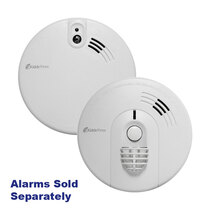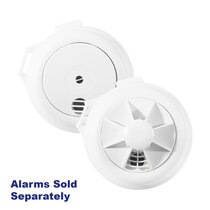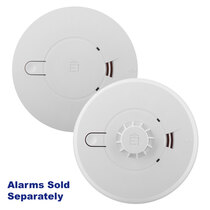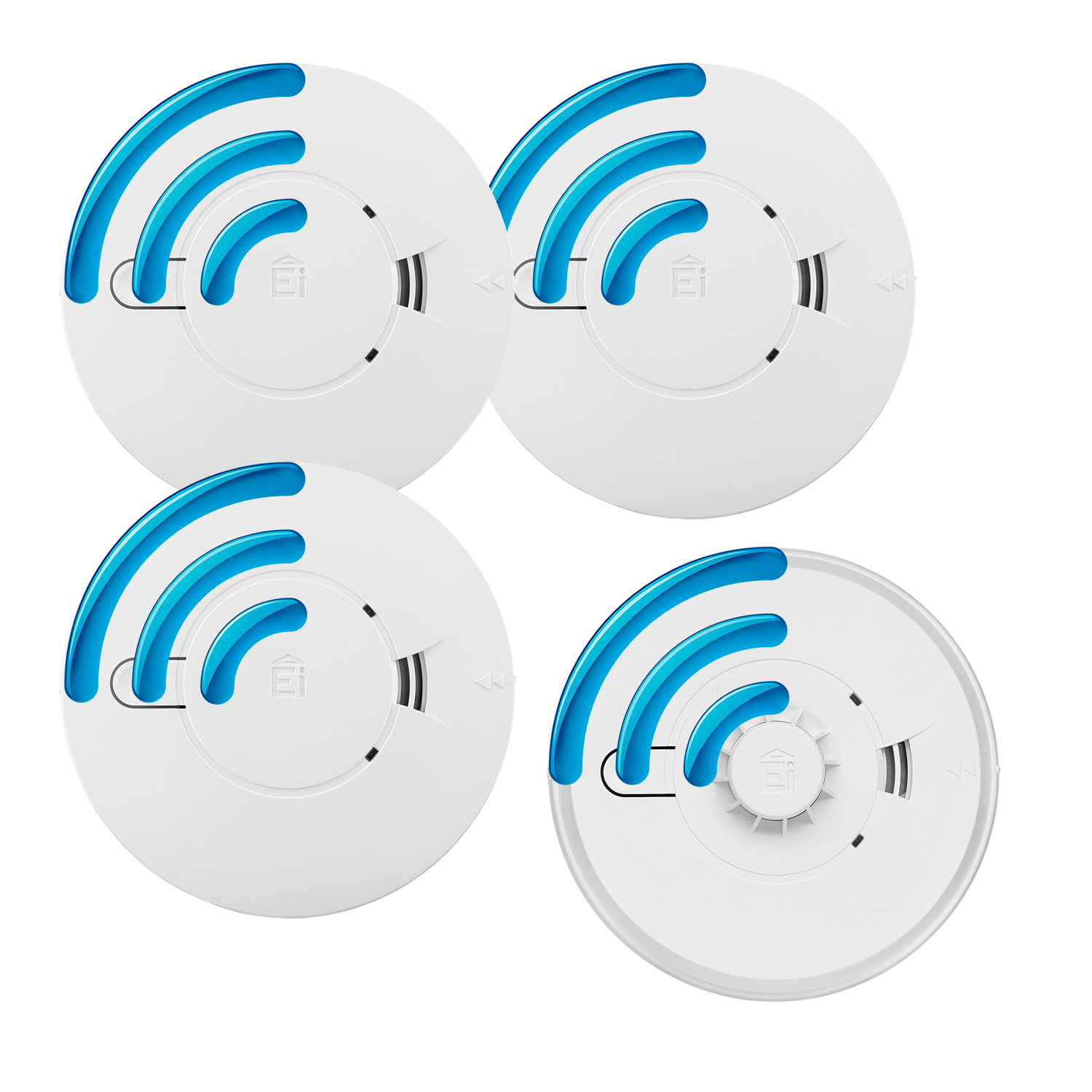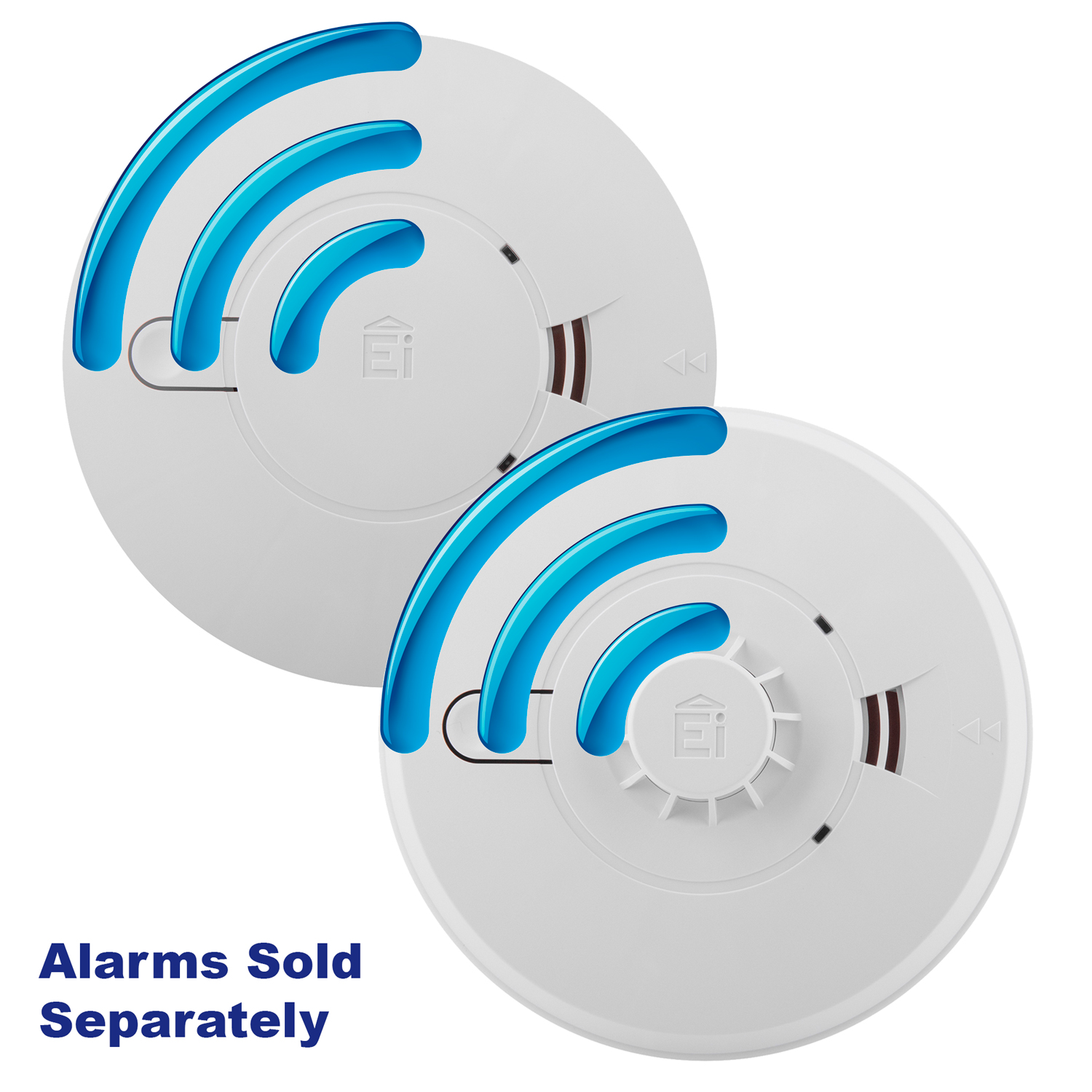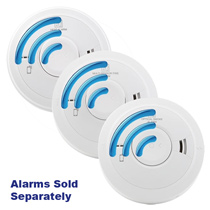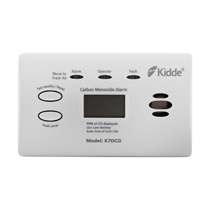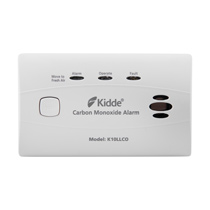-
Contact
Sales & Customer Service
0800 612 6537 support@safelincs.co.uk Live ChatDelivery Enquiries
0800 077 6149 - Resources
Fire & Safety Solutions
CALL OUR TEAM NOW 0800 612 6537
Lines open today 8am - 6pm
Free Delivery
on 100s of Products
Live Chat - Online
Instant help & Advice
Trade Discounts
and exclusive pricing
0% Credit Available
Open an account now
5 Star Customer Feedback
Alarms Suitable for Welsh Landlord Regulations
The new Renting Homes (Fitness for Human Habitation) (Wales) Regulations 2022 come into effect in July 2022 and stipulate that rented accommodation in Wales must be fitted with mains-powered and interlinked fire alarms with at least one smoke alarm installed on each storey of the dwelling. In addition, carbon monoxide detectors are required in each room of the dwelling that contains a carbon-fuelled appliance or flue. All products in this section have been selected to comply with the new regulations.
Power supply: All fire alarms must be powered either from the mains electricity circuit or a dedicated mains circuit from the consumer unit.
Interlink: Smoke and heat alarms must either be interlinked by cable or by wireless radio-frequency interlink. Carbon monoxide alarms do not have to interlink with the smoke and heat alarms.
Mains Powered 3 Smoke Alarms and 1 Heat Alarm Kit with Self-Charging 10 Year Back-up Battery - Kidde Firex KF-R Series
- Power: 230V mains powered with self-charging lithium back-up battery
- Back-up Battery: Self-charging 10 year back-up battery
- Warranty: 6 year warranty
- Hardwire interlink up to 24 compatible devices
- Suitable for BS 5839-6: 2019 Grade D1 installations
- Compliant with Scottish 2022, Welsh Landlord 2022, and Northern Ireland Landlord 2024 legislation
Mains Powered 2 Smoke Alarms and 1 Heat Alarm Kit with Alkaline Back-up Battery - Kidde Firex KF Series
- Power: 230V mains powered with alkaline back-up battery
- Back-up Battery: 9V alkaline battery (included)
- Warranty: 6 year warranty
- Hardwire interlink with up to 24 devices
- Suitable for BS 5839-6: 2019 Grade D2 installations
- Also suitable for both the Welsh and Scottish 2022 legislation
Mains Powered 3 Smoke Alarms and 1 Heat Alarm Kit with Alkaline Back-up Battery - Kidde Firex KF Series
- Power: 230V mains powered with alkaline back-up battery
- Back-up Battery: 9V alkaline battery (included)
- Warranty: 6 year warranty
- Hardwire interlink with up to 24 devices
- Suitable for BS 5839-6: 2019 Grade D2 installations
- Also suitable for both the Welsh and Scottish 2022 legislation
Mains Powered Smoke Alarms & Heat Alarms with Alkaline Back-up Battery - Kidde Firex KF Series
- 230V mains powered with alkaline back-up battery
- Available in Optical and Heat versions
- Interlink with up to 24 units
- Suitable for BS 5839-6: 2019 Grade D2 installations
- Kitemarked and CE marked
- Please note: alarms are sold individually
- Also suitable for both the Welsh and Scottish 2022 legislation
Mains Powered 2 Smoke Alarms and 1 Heat Alarm Kit with Self-Charging 10 Year Back-up Battery - Kidde Firex KF-R Series
- Power: 230V mains powered with self-charging lithium back-up battery
- Back-up Battery: Self-charging 10 year back-up battery
- Warranty: 6 year warranty
- Hardwire interlink up to 24 compatible devices
- Suitable for BS 5839-6: 2019 Grade D1 installations
- Compliant with Scottish 2022, Welsh Landlord 2022, and Northern Ireland Landlord 2024 legislation
Mains Powered Smoke Alarms & Heat Alarms with Self-Charging 10 Year Back-up Battery - Kidde Firex KF-R Series
- 230V mains powered with self-charging lithium back-up battery
- Available in Optical and Heat versions
- Interlinks with up to 24 units
- Suitable for BS 5839-6: 2013 Grade D1installations
- Kitemarked and CE marked
- Also suitable for both the Welsh and Scottish 2022 legislation
Mains Powered Smoke Alarms & Heat Alarms with Alkaline Back-up Battery - Firehawk BB Series
These Firehawk mains-powered smoke and heat alarms with hardwire interlink and replaceable AAA alkaline back-up batteries are suitable for Grade D2 systems to warn all occupants of a fire.
- 230V mains power with alkaline battery backup
- 6 years manufacturer's warranty
- Hardwire interlink up to 15 Firehawk FHN smoke and heat alarms.
- Also suitable for the 2022 Scottish legislation
Mains Powered Smoke Alarms & Heat Alarms with Alkaline Back-up Battery - Aico Ei140e Series
- 230V mains powered with alkaline back-up battery
- Available in Optical and Heat versions (Ei146e, Ei144e)
- Made in Ireland by Ei Electronics
- Interlinks with up to 12 units
- Kitemarked, CE marked and suitable for BS 5839-6: 2019 Grade D2 installations
- Please note: Alarms are sold individually
- Also suitable for both the Welsh and Scottish 2022 legislation
Mains Powered Radio-Interlink 2 Smoke Alarms and 1 Heat Alarm Kit with Alkaline Back-up Battery - Aico Ei140eRF Series
- Power: 230V mains powered with alkaline back-up battery
- Back-up Battery: 9V alkaline battery (included)
- Warranty: 5 year warranty
- Radio-interlink with up to 12 compatible devices
- Suitable for BS 5839-6: 2019 Grade D2 installations
- Compliant with Scottish 2022, Welsh Landlord 2022, and Northern Ireland Landlord 2024 legislation
Mains Powered Radio-Interlink 3 Smoke Alarms and 1 Heat Alarm Kit with Alkaline Back-up Battery - Aico Ei140eRF Series
- Power: 230V mains powered with alkaline back-up battery
- Back-up Battery: 9V alkaline battery (included)
- Warranty: 5 year warranty
- Radio-interlink with up to 12 compatible devices
- Suitable for BS 5839-6: 2019 Grade D2 installations
- Compliant with Scottish 2022, Welsh Landlord 2022, and Northern Ireland Landlord 2024 legislation
Mains Radio-Interlink Smoke Alarms & Heat Alarms with Alkaline Back-up Battery - Aico Ei140eRF Series
- 230V mains powered with alkaline back-up battery
- Available in Optical and Heat versions (Ei146eRF, Ei144eRF)
- Interlinks via radio frequency with up to 12 units
- Kitemarked, CE marked and suitable for BS 5839-6: 2019 Grade D2
- All alarms also act as repeaters
- Please note: alarms are sold individually
- Also suitable for both the Welsh and Scottish 2022 legislation
Mains Powered Smoke Alarms & Heat Alarms with Self-Charging 10 Year Back-up Battery - Firehawk RB Series
With self-charging back-up batteries, these mains-powered smoke and heat alarms from Firehawk won't need new batteries for their full 10 year lifespan. Ideal for Grade D1 and Scottish installations.
- 230V mains power with self-charging lithium battery backup
- 10 years manufacturer's warranty
- Hardwire interlink up to 15 Firehawk smoke and heat alarms.
- Also suitable for the 2022 Scottish legislation
Mains Powered Smoke Alarms & Heat Alarms with Self-Charging 10 Year Back-up Battery - Aico Ei3000 Series
- Available in Optical, Heat, Combined Optical & Heat, and Combined Heat & CO
- Mains powered alarms with sealed lithium back-up battery
- AudioLINK technology fitted as standard
- Interlinks with up to 12 compatible devices
- Compatible with Ei3000MRF SmartLINK Module for radio-interlinking
- Suitable for BS 5839-6: 2019 Grade D1 installations
- Also suitable for both the Welsh and Scottish 2022 legislation
Mains Radio-Interlink Smoke Alarms & Heat Alarms with Self-Charging 10 Year Back-up Battery - Aico Ei3000RF Series
- Available in Optical, Heat and Combined Optical and Heat
- Mains powered alarms with tamper-proof lithium back-up batteries
- Suitable for BS 5839-6: 2019 Grade D1 installations
- Supplied with an Ei3000MRF SmartLINK Module for radio-interlinking
- Hybrid (wired or wireless) interlinking with up to 12 compatible devices
- Please note: alarms are sold individually
- Also suitable for both the Welsh and Scottish 2022 legislation
Carbon Monoxide Detector 10 Yr Life - Kidde 5CO
- Product Life: 10 years
- Battery: AA batteries included
- Warranty: 7 year warranty
- LED status display
- CE Marked
- Kitemarked to BS EN 50291-1: 2018 (domestic use)
- Also suitable for the 2022 Welsh legislation
Digital Display Carbon Monoxide Alarm 10 Yr Warranty - Kidde 7DCO
- Product Life: 10 years
- Battery: replaceable AA alkaline batteries included
- Warranty: 10 year warranty
- Displays CO levels from 10ppm
- Peak Level Memory - recalls highest CO levels
- Ideal for domestic use and camping, caravans & boats
- Kitemarked to BS EN50291-1 and BS EN50291-2
- Also suitable for the 2022 Welsh legislation
10 Year Longlife Battery Carbon Monoxide Detector - Kidde 10LLCO
- Product Lifespan: 10 years
- Battery: Built-in, lasts the life time of your product – GUARANTEED
- Warranty: 10 year warranty
- Suitable for wall mounting and free-standing
- Kitemarked to BS EN 50291-1: 2018 (domestic use)
- Also suitable for both the Welsh and Scottish 2022 legislation
10 Year Longlife Battery Carbon Monoxide Alarm - FireAngel FA3820
- Product Lifespan: 10 years
- Battery: 10 year sealed lithium battery
- Warranty: 5 year warranty
- Reduced test volume at a single button press
- Kitemarked to BS EN 50291-1: 2018 (domestic use)
- Kitemarked to BS EN 50291-2: 2019 (camping / caravans / boats)
- Also suitable for both the Welsh and Scottish 2022 legislation
Mains Powered Carbon Monoxide Alarm with Self-Charging 10 Year Back-up Battery - Aico Ei3018
- Product Lifespan: 10 years
- Power: 230V mains powered with battery backup
- Backup Battery: Re-chargeable lithium battery
- Warranty: 5 year warranty
- AudioLINK: real time data extraction to a smart phone
- High performance electrochemical sensor
- Hardwire interlink with up to 12 compatible alarms
- Kitemarked to BS EN 50291-1: 2010
- Suitable for ceiling installation
- Also suitable for both the Welsh and Scottish 2022 legislation
Mains Radio-Interlinked Carbon Monoxide Alarm with Self-Charging 10 Year Back-up Battery - Aico Ei3018RF
- Product Lifespan: 10 years
- Power: 230V mains powered with battery backup
- Backup Battery: Re-chargeable lithium battery
- Warranty: 5 year warranty
- High performance CO sensor
- Interlinking with up to 12 devices
- Radio-interlinking via SmartLINK module (supplied)
- Kitemarked to BS EN 50291-1: 2010
- Suitable for ceiling installation
- Also suitable for both the Welsh and Scottish 2022 legislation
Page 1 (20 of 23 Products)
2022 Welsh Regulations
Updating the Renting Homes (Wales) Act 2016 (The Act) and coming into effect on 15th July 2022, the new regulations for landlords of rented dwellings cover a wide variety of topics relating to "fitness for human habitation" (FFHH). These include new requirements for smoke, heat, and carbon monoxide alarms to be installed and maintained by the landlord. A general summary of the new requirements are:
- At least one smoke alarm on each storey (e.g. hallways and landings).
- Consider additional smoke alarms depending on the size of the property.
- A heat alarm is usually required in each kitchen.
- The smoke and heat alarms must be ceiling-mounted, usually near the middle of the room.
- The smoke alarms must be sited such that they can be heard by the occupier when asleep.
- Smoke and heat alarms must be mains powered (fixed wiring, not a mains plug) and interlinked.
- A carbon monoxide alarm is required in any room with a gas, oil, or solid fuel burning appliance (e.g. boiler, gas cooker, fireplace).
- All alarms must be regularly maintained and tested by the landlord in accordance with the manufacturer's instructions.
For smoke and heat alarms, it can be compared to compliance with Grades D1 or D2 from BS 5839-6: 2019. Government guidance for the new regulations also stipulates that they should be installed in accordance with that same British Standard. See our full guide to BS 5839 Part 6 for more details.
It is the landlord's responsibility to ensure suitable alarms are correctly installed and working, not just at the start of each tenancy period but opportunities should be sought for ongoing testing and maintenance during the tenancy as well. The guidance page on gov.wales outlines the requirements for landlords to ensure a dwelling is fit for human habitation, including details on fire alarms and carbon monoxide detection.
Alarm Power Requirements
To meet the requirements of the new Welsh regulations applying to rented accommodation, smoke & heat alarms must be mains-powered with backup batteries and they must interlink with each other – Grade D1 or Grade D2 under the British Standard BS 5839-6: 2019. Grade D1 alarms are preferred as their backup battery is sealed, tamper-proof, and designed to last for the full lifespan of the alarm without needing to be replaced, ensuring full protection at all times.
Renting Homes (Fitness for Human Habitation) (Wales) Regulations 2022 allows carbon monoxide alarms with any power source to be used, including standard alkaline battery-powered alarms up to mains-powered alarms with sealed lithium backup and interlinked to your fire alarms.
Any mains-powered alarms, regardless of sensor type, must be permanently wired into a mains circuit. Alarms which use a mains plug are not suitable for the updated regulations.
Inspection and testing of electrical installation
Applying to all aspects of the property, including mains-powered smoke, heat, and CO alarms, the new regulations also require landlords ensure that all wiring and fixed electrical equipment are tested regularly – usually every 5 years unless a previous Electrical Installation Condition Report (EICR) stipulates more frequent inspections.
The "periodic inspection and testing" (PIT) of rented properties must be carried out only by a qualified person who is competent to work in accordance with the UK standard for the safety of electrical installations, BS 7671 Requirements for Electrical Installations (IET Wiring Regulations). The PIT will reveal if any circuits or equipment are overloaded, find any electric shock risks or fire hazards, identify faulty equipment or wiring, and note any lack of earthing or bonding.
These checks not only ensure that the fire detection and alarm system is working correctly, but help to reduce the risks of an electrical issue starting a fire in the first place.
British Standard Recommendations
British Standard BS 5839-6: 2019, the code of practice for fire detection and fire alarm systems in domestic premises, covers everything from system planning and design through to ongoing maintenance of an installed system. It contains guidance on the types of alarm available (known as Grades) and where they should be installed (called Categories).
Table 1 in the Standard outlines the minimum alarm systems for a wide range of example properties. The vast majority of rented dwellings require mains-powered interlinking smoke and heat alarms with sealed lifetime backup batteries – Grade D1 – installed in all circulation spaces such as hallways that form part of the escape routes from the premises and in all rooms or areas that present a high risk of fire to occupants – Category LD2.
The Grade system ranges from F1 & F2 (battery-powered) up to Grade A (comparable to commercial fire alarm systems) depending mostly on the power source and interlinking capabilities of the alarms – split Grades denote user-replaceable batteries as a 2 (e.g. F2) and sealed, tamper-proof batteries that last the full lifespan of the alarm with a 1 (e.g. D1). Higher Grades, approaching Grade A, and tamper-proof batteries for split Grades represent better protection.
Categories outline 3 different levels of coverage with LD3 having the fewest alarms and LD1 having the most. It is noted that an LD3 type system is intended to protect escape routes for those not directly involved in the fire and may not save the life of anyone in the immediate vicinity of the fire.
See our full guide to BS 5839 Part 6 for more details.
Interlink Compatibility
Hardwire Interlink
Smoke alarms, heat alarms, and carbon monoxide alarms powered from a mains circuit will usually also have an interlink or interconnect terminal next to the live and neutral wire terminals. If one alarm detects a fire or CO emergency it will pass the signal to the other units which will also sound an alarm throughout the property. This is particularly important for large buildings or if the bedroom is located far away from the kitchen. Outhouses and garages can also be connected into the radio-interlinked alarm system for added peace of mind.
Mains alarms can be connected to nearby lighting circuits for power, provided the light switch does not also turn off power to the alarm, but the interlink wire must be separate and not 'piggy-back' on a mains circuit as smoke, heat, and CO alarms are not designed to take 230V in their interlink terminal. If the property does not already have mains-powered alarms wired in, or if testing one of your existing alarms does not also cause the other alarms to sound, then an electrician will need to install a new interlink cable throughout the building.
Radio-Interlink
Radio-interlinked smoke alarms, heat alarms, and carbon monoxide alarms communicate with each other via radio frequency (RF). If one alarm detects a fire or CO emergency it will pass the signal to the other units which will also sound an alarm throughout the property. This is particularly important for large buildings or if the bedroom is located far away from the kitchen. Outhouses and garages can also be connected into the radio-interlinked alarm system for added peace of mind.
Radio-interlinked alarms are sometimes referred to as wireless alarms, although this can be confusing when dealing with radio-interlinked units wired into the mains power supply in a building. Radio-interlinked mains powered alarms can contain a sealed back-up battery which lasts the full ten years of the alarm's life, a long life lithium back-up battery, or an alkaline back-up battery.
Compatibility
Only interlink alarms with alarms from the same model range and manufacturer. Alarms from different manufacturers are not compatible and attempting to interlink them could damage the alarms. If in doubt, check the instruction manual for the alarms before purchase – we provide PDF instruction manual downloads for the majority of smoke, heat, and CO alarms on our website.
Some ranges support mixing hardwired and radio-interlink alarms in the same network, which can reduce electrician costs and disruption. All alarms on each storey would be connected together via hardwire interlink, with one alarm on each storey also being connected to each other via RF signal. This could also save money on product costs, as mains-powered alarms without radio-interlink are usually the cheapest option for interlinking alarms. Please confirm before purchase if you require this functionality.






















